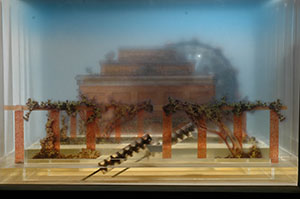 |
||
| [close] | ||
 |
© Institute and Museum of the History of Science |
The hydraulic systems in the Mesopotamian Hanging GardensWorking models Opera Laboratori Fiorentini The "Royal Gardens" of Babylon are mentioned in cuneiform inscriptions from the 3rd and 2nd millennium B.C., but it is not clear whether they can be identified with the famous "Hanging Gardens" created in the 1st millennium B.C. by Nebuchadnezzar II and destined to become one of the seven wonders of the ancient world. Although it is impossible to state with certainty which devices were used for their irrigation, we know that machines for lifting water, such as water-wheels and Archimedean screws, existed. These are, in fact, the two devices here displayed: the Archimedean screws raise the water from a lower level to a higher one according to a scheme that can be repeated up to notable heights. Behind the structure, barely visible, a noria is moving, with buckets tied around its circumference. Introduced into a watercourse, it is put in motion by the current. The vessels fill up and then, through the force of gravity, empty the water into a canal, from where it starts to flow down toward the lower levels. |